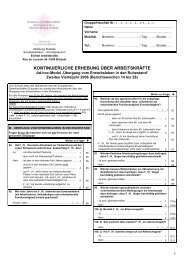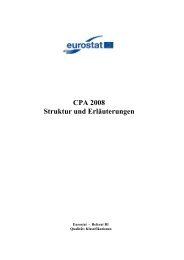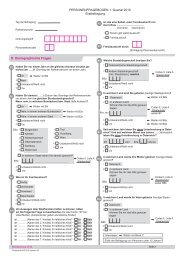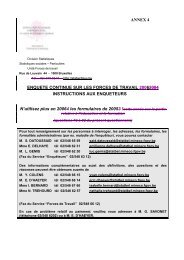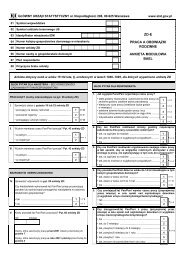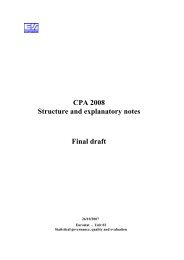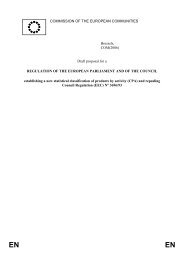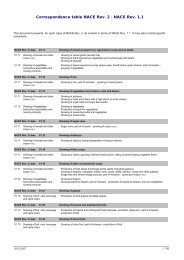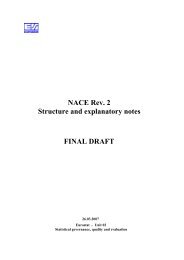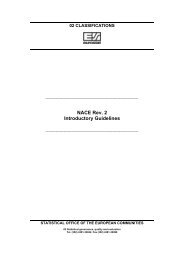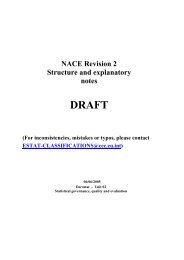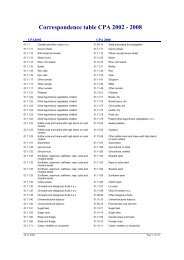Implementation of NACE Rev. 2 in Business ... - CIRCA - Europa
Implementation of NACE Rev. 2 in Business ... - CIRCA - Europa
Implementation of NACE Rev. 2 in Business ... - CIRCA - Europa
You also want an ePaper? Increase the reach of your titles
YUMPU automatically turns print PDFs into web optimized ePapers that Google loves.
Task Force on the implementation <strong>of</strong><br />
<strong>NACE</strong> <strong>Rev</strong>. 2<br />
<strong>Implementation</strong> <strong>of</strong> <strong>NACE</strong> <strong>Rev</strong>. 2<br />
<strong>in</strong> Bus<strong>in</strong>ess Registers<br />
Version 1.0<br />
March 2006
Preface<br />
Economic activity is a key variable for statistical bus<strong>in</strong>ess registers, form<strong>in</strong>g the basis for stratify<strong>in</strong>g<br />
samples and analys<strong>in</strong>g outputs. Classifications <strong>of</strong> economic activity need to be revised periodically to<br />
ensure that they cont<strong>in</strong>ue to reflect economic developments. Any change will require re-cod<strong>in</strong>g <strong>of</strong> at<br />
least some <strong>of</strong> the units held on the bus<strong>in</strong>ess register.<br />
The system <strong>of</strong> economic activities is be<strong>in</strong>g revised, start<strong>in</strong>g with the ISIC, followed by the <strong>NACE</strong>.<br />
With<strong>in</strong> the European Union, there will be a requirement to use the new version <strong>of</strong> <strong>NACE</strong> - <strong>NACE</strong><br />
<strong>Rev</strong>. 2 - for statistical data describ<strong>in</strong>g year 2008 and later. For this reason <strong>NACE</strong> <strong>Rev</strong>. 2 will be<br />
<strong>in</strong>troduced <strong>in</strong> statistical bus<strong>in</strong>ess registers <strong>in</strong> 2008, at the latest.<br />
All EU countries use <strong>NACE</strong>, or a national version derived from <strong>NACE</strong> (called here <strong>NACE</strong>+). So if<br />
<strong>NACE</strong> changes, the national classifications will also change at the more detailed level, to reflect<br />
national requirements.<br />
Eurostat felt that the conversion to <strong>NACE</strong> <strong>Rev</strong>. 2 should be guided by a Task Force on<br />
<strong>Implementation</strong>. From February 2005 onwards the Task Force has been develop<strong>in</strong>g guidance to help<br />
Member States to implement <strong>NACE</strong> <strong>Rev</strong>. 2 <strong>in</strong> their bus<strong>in</strong>ess registers and statistical outputs. The first<br />
step was to send a questionnaire to all national statistical <strong>in</strong>stitutes (NSI’s), to be able to identify the<br />
issues that they faced <strong>in</strong> the implementation. The results showed consensus over the issues that the<br />
Task Force has to document. Eurostat agreed to promote and coord<strong>in</strong>ate the publication <strong>of</strong> four<br />
handbooks that would <strong>in</strong>clude general advice and specific recommendations relat<strong>in</strong>g to bus<strong>in</strong>ess<br />
registers, sampl<strong>in</strong>g and back-cast<strong>in</strong>g.<br />
This document focuses on statistical bus<strong>in</strong>ess registers and outl<strong>in</strong>es best practices that are used <strong>in</strong> a<br />
range <strong>of</strong> countries, so that readers can judge which approach might be most appropriate to their<br />
countries.<br />
This paper was drafted by Ton Bonné (CBS-Netherlands), <strong>in</strong> close cooperation with John Perry and<br />
Steve Vale (ONS United K<strong>in</strong>gdom), Arto Luhtio (Eurostat), and advised by many others.<br />
Available <strong>in</strong>formation: tools from Eurostat<br />
The structure <strong>of</strong> <strong>NACE</strong> <strong>Rev</strong>. 2 was f<strong>in</strong>alised by the <strong>NACE</strong>/CPA work<strong>in</strong>g group meet<strong>in</strong>g <strong>in</strong> September<br />
2005. It was approved by the Statistical Programme Committee and is currently submitted to the EU-<br />
Council and the European Parliament. It will be ‘f<strong>in</strong>al’ after publication <strong>in</strong> the Official Journal, which<br />
is expected by the end <strong>of</strong> 2006. It shall be applied from January 2008.<br />
The explanatory notes as well as the correspondence tables are available on the "Operation 2007"<br />
website http://forum.europa.eu.<strong>in</strong>t/irc/dsis/nacecpacon/<strong>in</strong>fo/data/en/<strong>in</strong>dex.htm and will be cont<strong>in</strong>uously<br />
improved.<br />
2
Contents<br />
1. Preparation <strong>of</strong> the bus<strong>in</strong>ess register Page 4<br />
1.1 First step: develop<strong>in</strong>g an implementation plan<br />
1.2 Estimat<strong>in</strong>g changes and creat<strong>in</strong>g a research environment<br />
1.3 Likely timetable, critical time path<br />
1.4 Units <strong>in</strong> the bus<strong>in</strong>ess register<br />
1.5 Communication <strong>of</strong> changes<br />
2. Sources Page 6<br />
2.1 External sources<br />
2.2 Internal sources<br />
2.3 Exist<strong>in</strong>g bus<strong>in</strong>ess activity descriptions (<strong>in</strong>ternal or external)<br />
2.4 Pr<strong>of</strong>il<strong>in</strong>g<br />
3. Tools for surveys Page 7<br />
3.1 Use <strong>of</strong> <strong>in</strong>dexes<br />
3.2 Computer aided cod<strong>in</strong>g systems<br />
3.3 ´Automatic Cod<strong>in</strong>g by Text Recognition’ as example<br />
4. Theoretical issues and practical rules Page 9<br />
4.1 Determ<strong>in</strong>ation <strong>of</strong> the pr<strong>in</strong>cipal activity <strong>in</strong> theory and <strong>in</strong> practice<br />
4.2 Use <strong>of</strong> PRODCOM data for assign<strong>in</strong>g the new codes<br />
4.3 Assign<strong>in</strong>g new codes to units <strong>in</strong> the register<br />
4.4 Construct<strong>in</strong>g probabilistic conversion matrixes<br />
5. Realisation by surveys Page 10<br />
5.1 Prepar<strong>in</strong>g for survey<br />
5.2 Surveys<br />
5.3 Quality controls<br />
5.4 Priority rules<br />
5.5 Recod<strong>in</strong>g the bus<strong>in</strong>ess register<br />
5.6 Treatment <strong>of</strong> corrections<br />
5.7 Dual cod<strong>in</strong>g<br />
6. Follow up Page 14<br />
Acronyms<br />
ACTR: Automatic Cod<strong>in</strong>g by Text Recognition<br />
CPA: Classification <strong>of</strong> Products by Activity<br />
ISIC: International Standard Industrial Classification<br />
<strong>NACE</strong>: Nomenclature statistique des Activités économiques dans la Communauté Européenne<br />
<strong>NACE</strong> <strong>Rev</strong>. 1.1: <strong>NACE</strong> version <strong>of</strong> 2003<br />
<strong>NACE</strong> <strong>Rev</strong>. 2: <strong>NACE</strong> version <strong>of</strong> 2008<br />
<strong>NACE</strong>+: National version <strong>of</strong> <strong>NACE</strong><br />
NSI: National Statistical Institute<br />
3
1. Preparation <strong>of</strong> bus<strong>in</strong>ess registers<br />
1.1 First step: develop<strong>in</strong>g an implementation plan<br />
The implementation at the level <strong>of</strong> <strong>in</strong>dividual countries will be a wide-rang<strong>in</strong>g project. Seven ma<strong>in</strong><br />
elements can be dist<strong>in</strong>guished.<br />
• Development <strong>of</strong> a national classification (<strong>in</strong> all but a few Member States)<br />
• <strong>Implementation</strong> <strong>of</strong> CPA/PRODCOM (<strong>in</strong> some countries after the development <strong>of</strong> a national<br />
version)<br />
• Contact with adm<strong>in</strong>istrative source departments (sources) provid<strong>in</strong>g the bus<strong>in</strong>ess register with<br />
activity codes<br />
• <strong>Rev</strong>ision and approval <strong>of</strong> legal acts<br />
• <strong>Implementation</strong> <strong>in</strong> the bus<strong>in</strong>ess register<br />
• <strong>Implementation</strong> <strong>in</strong> the statistical collections and outputs, <strong>in</strong>clud<strong>in</strong>g social surveys<br />
• Communication with users<br />
In this document, attention is focused ma<strong>in</strong>ly on implementation <strong>in</strong> the statistical bus<strong>in</strong>ess registers<br />
and the source registers.<br />
1.2 Estimat<strong>in</strong>g changes and creat<strong>in</strong>g a research environment<br />
When <strong>NACE</strong> <strong>Rev</strong>. 2 and <strong>NACE</strong>+ are f<strong>in</strong>ished and correspondence tables are made, the extent <strong>of</strong> the<br />
classification change can be seen. The impact <strong>of</strong> changes can be communicated with<strong>in</strong> the NSI.<br />
An assessment can be made concern<strong>in</strong>g the numbers <strong>of</strong> units that can be coded automatically (1 to 1<br />
and N to 1) and those that have to be checked (1 to N and M to N). This can be done by us<strong>in</strong>g<br />
coord<strong>in</strong>ated figures or selection <strong>of</strong> target populations. The impact <strong>of</strong> the change and the methods to be<br />
used to implement the changes can be assessed.<br />
Often it is a prerequisite to create a research environment. All <strong>in</strong>formation concern<strong>in</strong>g recod<strong>in</strong>g has to<br />
be stored because it can not be directly applied <strong>in</strong> the Register for technical reasons. It is necessary<br />
that a database with coord<strong>in</strong>ated <strong>in</strong>formation exists as well as a process<strong>in</strong>g tool to assign codes. Small<br />
enterprises, <strong>in</strong> particular, will need several methodologies to be comb<strong>in</strong>ed <strong>in</strong> an optimal way. The<br />
database will therefore comb<strong>in</strong>e recod<strong>in</strong>g from codes supplied by adm<strong>in</strong>istrative sources, bus<strong>in</strong>ess<br />
activity descriptions, bus<strong>in</strong>ess pr<strong>of</strong>il<strong>in</strong>g, statistical surveys and based on probabilistic models.<br />
1.3 Likely timetable, critical time path<br />
The key date for bus<strong>in</strong>ess registers is 1 January 2008, when all units on the register should be coded to<br />
the new version <strong>of</strong> the national classification. With this date, Structural Bus<strong>in</strong>ess Statistics for 2008<br />
can be based on <strong>NACE</strong> <strong>Rev</strong>. 2 and September 2011 is guaranteed for national accounts. Some<br />
countries are able to switch to <strong>NACE</strong> <strong>Rev</strong>. 2 earlier, while others may require the Structural Bus<strong>in</strong>ess<br />
Statistics itself to complete the recod<strong>in</strong>g to <strong>NACE</strong> <strong>Rev</strong>. 2.<br />
There is no need to have the bus<strong>in</strong>ess register recoded (completely) at this specific deadl<strong>in</strong>e. The<br />
bus<strong>in</strong>ess register must be recoded before it is used as a basis for the preparation <strong>of</strong> the surveys for<br />
2008 (mandatory).<br />
Because <strong>of</strong> the necessity for coord<strong>in</strong>ation with<strong>in</strong> NSI and with adm<strong>in</strong>istrative departments, it is useful<br />
to go for a s<strong>in</strong>gle date, January 1st 2008. The necessary work will therefore need to be timetabled<br />
4
ased on this date. The dates mentioned <strong>in</strong> the table below have to <strong>in</strong>terpreted as ‘approximate’<br />
depend<strong>in</strong>g on your own NSI-situation.<br />
Activity When<br />
<strong>NACE</strong> f<strong>in</strong>alised September 2005<br />
<strong>NACE</strong> implementation plan December 2005<br />
Initial estimate <strong>of</strong> the impact <strong>of</strong> the change <strong>in</strong> the register April 2006<br />
Structure <strong>of</strong> national version <strong>of</strong> <strong>NACE</strong> ready, followed by<br />
explanatory notes, <strong>in</strong>dexes, cod<strong>in</strong>g tools, conversion schemes etc.<br />
National register implementation plan f<strong>in</strong>alised, <strong>in</strong>clud<strong>in</strong>g <strong>in</strong>ternal<br />
and external sources to use, surveys required and use <strong>of</strong><br />
probabilistic models.<br />
5<br />
June 2006 (for<br />
some a little later)<br />
July 2006 (for some<br />
a little later)<br />
Start <strong>of</strong> gather<strong>in</strong>g <strong>in</strong>formation September 2006<br />
Changes to the register database to allow dual cod<strong>in</strong>g January 2007<br />
Probabilistic methods to reclassify units without alternative source July 2007<br />
Information gathered to reclassify all units Until October 2007<br />
Units <strong>in</strong> Bus<strong>in</strong>ess register coded to both <strong>NACE</strong> <strong>Rev</strong>. 1.1 and <strong>Rev</strong>. 2 From January 2008<br />
Dual cod<strong>in</strong>g <strong>in</strong> bus<strong>in</strong>ess register From January 2008<br />
to December 2010*<br />
* The time to have dual cod<strong>in</strong>g depends on the tim<strong>in</strong>g <strong>of</strong> National Accounts. It will probably be three years.<br />
1.4 Units <strong>in</strong> the bus<strong>in</strong>ess register<br />
Accord<strong>in</strong>g to the new draft EU Regulation on bus<strong>in</strong>ess registers there will be three types <strong>of</strong> statistical<br />
units for which a classification is required, that is local units, enterprises and enterprise groups.<br />
Although not required for the legal unit, it may be necessary to recode these <strong>in</strong> order to permit the<br />
classification <strong>of</strong> the enterprise. In case <strong>of</strong> adm<strong>in</strong>istrative sources, this <strong>in</strong>formation on legal units may<br />
be supplied as bus<strong>in</strong>ess activity descriptions or as codes from the exist<strong>in</strong>g <strong>NACE</strong> or other cod<strong>in</strong>g<br />
systems. All <strong>of</strong> these have to be coded to <strong>NACE</strong> <strong>Rev</strong>. 2.<br />
In many countries (local) k<strong>in</strong>d <strong>of</strong> activity units have to be recoded as well.<br />
1.5 Communication <strong>of</strong> changes<br />
The activity codes <strong>in</strong> the bus<strong>in</strong>ess register are <strong>of</strong> importance to many users. They have to be updated:<br />
• For <strong>in</strong>ternal (NSI) users it is important to discuss the changes with<strong>in</strong> statistical doma<strong>in</strong>s. In<br />
this way, changes <strong>in</strong> statistical outputs and samples can be analysed, quality targets set and<br />
knowledge exchanged.<br />
• External users may be <strong>in</strong>formed by web site, press brief<strong>in</strong>g or a specific help desk. Mail<strong>in</strong>g<br />
lists may be composed.
2. Sources<br />
In many countries the adm<strong>in</strong>istrative sources play an important role <strong>in</strong> updat<strong>in</strong>g the bus<strong>in</strong>ess register.<br />
They may also play an important role <strong>in</strong> implement<strong>in</strong>g <strong>NACE</strong> <strong>Rev</strong>. 2.<br />
2.1 External sources<br />
Because <strong>of</strong> exist<strong>in</strong>g dependencies on external registers (for example, bus<strong>in</strong>ess registration by tax,<br />
social security, Chambers <strong>of</strong> Commerce) or because <strong>of</strong> restricted capacity, it may be necessary to use<br />
and adapt these external sources to statistical needs. This process <strong>in</strong>cludes:<br />
• Early warn<strong>in</strong>g to enable sources to implement changes at a convenient time<br />
• Provision <strong>of</strong> <strong>in</strong>struments like explanatory notes, <strong>in</strong>dexes, correspondence tables to the external<br />
sources<br />
• Assistance with the adaptation <strong>of</strong> computer systems and cod<strong>in</strong>g tools<br />
• Dissem<strong>in</strong>ation <strong>of</strong> <strong>in</strong>formation to the employees <strong>of</strong> the external source who operate the system,<br />
assign codes or audit (presentations, guides, tra<strong>in</strong><strong>in</strong>g). This should be well-timed<br />
This may help to prevent external sources reta<strong>in</strong><strong>in</strong>g their exist<strong>in</strong>g classification codes and systems.<br />
The ideal situation would be to have the adm<strong>in</strong>istrative sources convert to the new classification at<br />
exactly the same time as the statistical bus<strong>in</strong>ess registers <strong>of</strong> NSI’s. In this case these sources can help<br />
to determ<strong>in</strong>e the correct new code for a bus<strong>in</strong>ess. As far as legally possible <strong>in</strong>ternal NSI-codes and<br />
additional NSI-<strong>in</strong>formation should be handed over to the sources. In this way double work can be<br />
avoided and cooperation can be optimized.<br />
External sources that may be important as a source <strong>of</strong> <strong>in</strong>formation:<br />
• Chambers <strong>of</strong> Commerce, taxes (VAT, wages etc.), social security. (activity, existence)<br />
• Trade associations, Yellow Pages, telephone directories<br />
External sources are especially important for <strong>in</strong>formation on medium sized enterprises.<br />
2.2 Internal sources<br />
Like external sources, <strong>in</strong>ternal sources can be important to prevent unnecessary approaches to<br />
bus<strong>in</strong>esses. Of course <strong>in</strong>ternal sources should be co-ord<strong>in</strong>ated <strong>in</strong> implement<strong>in</strong>g and us<strong>in</strong>g <strong>NACE</strong> <strong>Rev</strong>.<br />
2. So all <strong>of</strong> the available <strong>in</strong>formation should be <strong>in</strong>vestigated:<br />
• Exist<strong>in</strong>g <strong>in</strong>formation from statistics.<br />
• Information from pr<strong>of</strong>il<strong>in</strong>g <strong>of</strong> the large and complex enterprises.<br />
• Information from branch specialists <strong>of</strong> NSI with<strong>in</strong> the own competence fields<br />
• The exist<strong>in</strong>g (5 th digit) <strong>NACE</strong>+-codes based on the old <strong>NACE</strong> may suffice to classify to<br />
<strong>NACE</strong> <strong>Rev</strong>. 2.<br />
2.3 Exist<strong>in</strong>g bus<strong>in</strong>ess activity descriptions (<strong>in</strong>ternal or external)<br />
Descriptions <strong>of</strong> bus<strong>in</strong>ess activities are useful for chang<strong>in</strong>g the classification <strong>of</strong> register units. They may<br />
<strong>of</strong>fer sufficient <strong>in</strong>formation to make a split follow<strong>in</strong>g <strong>NACE</strong> <strong>Rev</strong>. 2. These may be registered by<br />
external sources (e.g. Tax-<strong>of</strong>fice, Chambers <strong>of</strong> Commerce) or the statistical agencies themselves.<br />
The sort <strong>of</strong> description may vary <strong>in</strong> quality, depend<strong>in</strong>g on the way the <strong>in</strong>formation is collected. For<br />
<strong>in</strong>stance a comb<strong>in</strong>ation <strong>of</strong> free text and closed boxes gives good results.<br />
6
The quality <strong>of</strong> the activity description decreases after some time. Therefore it is helpful to store dates<br />
with descriptions as a quality <strong>in</strong>dicator or confidence rat<strong>in</strong>g. Low confidence means that the entity<br />
should be contacted aga<strong>in</strong>.<br />
When bus<strong>in</strong>ess activity descriptions are not directly l<strong>in</strong>ked to a cod<strong>in</strong>g system they may be held only<br />
on paper. But even then there may be a considerable sav<strong>in</strong>g possible <strong>in</strong> terms <strong>of</strong> response burden for<br />
bus<strong>in</strong>esses.<br />
Attention should be paid to bus<strong>in</strong>ess activity descriptions <strong>of</strong> non-statistical sources. They have to<br />
conta<strong>in</strong> real activity <strong>in</strong>formation <strong>in</strong>stead <strong>of</strong> legal or statutory descriptions.<br />
2.4 Pr<strong>of</strong>il<strong>in</strong>g<br />
One method for determ<strong>in</strong><strong>in</strong>g the correct new code for key bus<strong>in</strong>esses is pr<strong>of</strong>il<strong>in</strong>g, which is def<strong>in</strong>ed as:<br />
‘a method to analyse the legal, operational and account<strong>in</strong>g structure <strong>of</strong> an enterprise group <strong>in</strong><br />
order to establish the statistical units with<strong>in</strong> that group, their l<strong>in</strong>ks and the most efficient<br />
structure for the collection <strong>of</strong> data’.<br />
Pr<strong>of</strong>il<strong>in</strong>g can be carried out <strong>in</strong> three ways:<br />
• Face to face meet<strong>in</strong>gs: expensive but essential for the larger and more complex groups<br />
• Other contact, by telephone, fax, e-mail or post, with details gathered to determ<strong>in</strong>e structures<br />
• Us<strong>in</strong>g exist<strong>in</strong>g <strong>in</strong>formation for relative simple groups, where <strong>in</strong>formation available from<br />
adm<strong>in</strong>istrative sources, surveys or even web-sites may suffice. Annual accounts may be<br />
helpful as well.<br />
The number <strong>of</strong> units which can be coded by <strong>in</strong>formation from pr<strong>of</strong>il<strong>in</strong>g is not high. The relative<br />
importance however is much higher because the <strong>in</strong>formation concerns larger units. Information from<br />
pr<strong>of</strong>il<strong>in</strong>g could be exchanged with regular sources, if this is legally allowed.<br />
3. Tools for surveys<br />
Several tools can be helpful to the recod<strong>in</strong>g process. Some are mentioned here.<br />
3.1 Use <strong>of</strong> <strong>in</strong>dexes<br />
Generally speak<strong>in</strong>g, us<strong>in</strong>g structural standardized <strong>in</strong>formation permits the construction and use <strong>of</strong><br />
<strong>in</strong>dexes. Indexes are alphabetical or code related digital lists and may conta<strong>in</strong> both activities and/or<br />
products <strong>in</strong> a structurally presented way. The assign<strong>in</strong>g <strong>of</strong> codes by us<strong>in</strong>g <strong>in</strong>dexes is much easier. A<br />
list <strong>of</strong> activity descriptions also helps assign<strong>in</strong>g codes. So when <strong>in</strong>terpret<strong>in</strong>g exist<strong>in</strong>g <strong>in</strong>formation on<br />
activities or evaluat<strong>in</strong>g that <strong>in</strong>formation from <strong>in</strong>quiries, <strong>in</strong>dexes may be <strong>of</strong> great help to all countries.<br />
Indexes have to be developed by the Member States themselves at <strong>NACE</strong>+-level. This means that<br />
several countries have to do some <strong>of</strong> the same tasks, especially if they share the same language.<br />
Coord<strong>in</strong>ation between Member States organised by Eurostat may help.<br />
A search eng<strong>in</strong>e may be operated to consult <strong>in</strong>dexes.<br />
7
3.2 Computer aided cod<strong>in</strong>g systems<br />
As was evident from the questionnaire sent to the Member States not many countries use computer<br />
aided cod<strong>in</strong>g, or even more advanced systems.<br />
Although <strong>in</strong>dexes with connected search systems are sometimes described as a cod<strong>in</strong>g tool, there are<br />
basically two types <strong>of</strong> more advanced systems:<br />
First there are systems based on l<strong>in</strong>guistic eng<strong>in</strong>eer<strong>in</strong>g. In this case text descriptions are<br />
related, recognis<strong>in</strong>g words which may be <strong>in</strong> a different order etc. This approach is highly<br />
language dependent, so with 20 languages not suitable for a common Eurostat purpose.<br />
Secondly there are systems which use str<strong>in</strong>g match<strong>in</strong>g. These work by stor<strong>in</strong>g descriptions and<br />
codes. If a description scores more than a preset value the match is accepted and the code is<br />
used. It is possible to set score levels to give different trade-<strong>of</strong>fs between quality <strong>of</strong> codes and<br />
quantity <strong>of</strong> descriptions. These systems will work <strong>in</strong> all languages as long as the <strong>in</strong>dex is<br />
translated.<br />
All cod<strong>in</strong>g tools require comprehensive metadata to build <strong>in</strong>dex entries. Obviously it takes much time<br />
to implement a new classification <strong>in</strong>to a cod<strong>in</strong>g system before the results meet the required quality<br />
standards.<br />
3.3 ‘Automatic Cod<strong>in</strong>g by Text Recognition’ as example<br />
ACTR is an example <strong>of</strong> a str<strong>in</strong>g match<strong>in</strong>g system. The system comes from Statistics Canada. It is a<br />
generalized system <strong>in</strong>dependent <strong>of</strong> the used classification and language. For these reasons ACTR can<br />
be adopted by different countries and utilised for several classifications (economic activities, products,<br />
pr<strong>of</strong>essions, etc.).<br />
To give good results ACTR has to be fed with a lot <strong>of</strong> material:<br />
• All the head<strong>in</strong>gs and explanatory notes <strong>of</strong> the considered classification<br />
• All the descriptions <strong>of</strong> the connected classifications (e.g. PRODCOM)<br />
• Additional text from bus<strong>in</strong>ess surveys<br />
ACTR assigns codes to descriptions and requires descriptions <strong>of</strong> activities that are as correct as<br />
possible. To be able to code, a pars<strong>in</strong>g strategy is operated. Pars<strong>in</strong>g means that rough <strong>in</strong>put text from<br />
the respondent is adapted to text <strong>in</strong> the ACTR database <strong>in</strong> order to be able to match and to assign<br />
codes. The larger the database, the more possibilities are available to ACTR. A transformation file to<br />
code and recode and sufficient disk space are also required. It is also possible to set score levels<br />
between the quality <strong>of</strong> cod<strong>in</strong>g and the quantity <strong>of</strong> descriptions coded.<br />
Conclusions about ACTR<br />
• ACTR needs a lot <strong>of</strong> databases. This need can only be met when a register with descriptions is<br />
already operated (either by the NSI or at the sources) or all units are surveyed by<br />
questionnaires with open questions.<br />
• For the match<strong>in</strong>g, it is necessary that the database is fed with full explanatory notes <strong>of</strong> the<br />
country’s own SIC, PRODCOM etc.<br />
• ACTR can be used for other classifications if suitable <strong>in</strong>dexes are created;<br />
Although ACTR may be an excellent <strong>in</strong>strument to code units, from our po<strong>in</strong>t <strong>of</strong> view it is not useful<br />
to oblige countries to use such a system. Some countries will not be able to meet the standards<br />
(elaborat<strong>in</strong>g the database causes a lot <strong>of</strong> work), while others will already use <strong>in</strong>dexes or a cod<strong>in</strong>g tool<br />
that do not exactly meet the standards <strong>of</strong> ACTR. Besides, emphasis should be on <strong>in</strong>troduc<strong>in</strong>g new<br />
codes, not on the development <strong>of</strong> new <strong>in</strong>struments.<br />
8
4. Theoretical issues and practical rules<br />
4.1 Determ<strong>in</strong>ation <strong>of</strong> the pr<strong>in</strong>cipal activity <strong>in</strong> theory and <strong>in</strong> practice<br />
As stated <strong>in</strong> the <strong>NACE</strong> <strong>in</strong>troduction, the pr<strong>in</strong>cipal activity <strong>of</strong> statistical units should be determ<strong>in</strong>ed<br />
accord<strong>in</strong>g to value added, where possible. If this is not possible, a proxy can be used. Several proxies<br />
are discussed <strong>in</strong> this document. There are no clear priority rules for the use <strong>of</strong> different proxies. The<br />
use <strong>of</strong> a certa<strong>in</strong> proxy depends on several factors, such as the <strong>in</strong>formation available for the statistical<br />
unit concerned, cost-benefit considerations and the country practices. The pr<strong>in</strong>cipal activity, and<br />
secondary activities where applicable, data <strong>of</strong> all statistical units recorded <strong>in</strong> the bus<strong>in</strong>ess registers<br />
need to be coded accord<strong>in</strong>g to <strong>NACE</strong> <strong>Rev</strong>. 2 from January 1st 2008 onwards. Although the basic<br />
situation is the same, practice varies considerably.<br />
Value added can be used most <strong>of</strong>ten for enterprise groups, possibly for enterprises, but hardly ever for<br />
local units.<br />
4.2 Use <strong>of</strong> PRODCOM data for assign<strong>in</strong>g the new codes<br />
The central problem <strong>of</strong> the implementation <strong>of</strong> a new classification is the efficient and reliable recod<strong>in</strong>g<br />
<strong>of</strong> the activities <strong>of</strong> the statistical units. There is a variety <strong>of</strong> methods available, a mix <strong>of</strong> which will be<br />
used depend<strong>in</strong>g on the specific circumstances <strong>in</strong> the different doma<strong>in</strong>s. S<strong>in</strong>ce <strong>in</strong>formation for recod<strong>in</strong>g<br />
the pr<strong>in</strong>cipal activity is limited but recod<strong>in</strong>g has to be done before new statistical <strong>in</strong>formation becomes<br />
available, all available sources <strong>of</strong> <strong>in</strong>formation have to be used efficiently.<br />
A possible source <strong>of</strong> <strong>in</strong>formation is data based on PRODCOM or a national version <strong>of</strong> it. Of course<br />
this source <strong>of</strong> <strong>in</strong>formation can only be used for units <strong>in</strong> the PRODCOM-survey, i.e. <strong>NACE</strong> <strong>Rev</strong>. 1.1.,<br />
section C to E.<br />
If the new CPA is implemented <strong>in</strong> the PRODCOM survey, the production values <strong>of</strong> the new <strong>NACE</strong><br />
<strong>Rev</strong>. 2 classes can easily be aggregated. If not, the production values first have to be converted to the<br />
new cod<strong>in</strong>g system. Therefore it is very important that the 2007 PRODCOM list is already double<br />
coded accord<strong>in</strong>g to the old and the new classification.<br />
4.3 Assign<strong>in</strong>g new codes to units <strong>in</strong> the register<br />
It is a major operation to have the register populated completely with <strong>NACE</strong> <strong>Rev</strong>. 2 by January 2008.<br />
Not only enterprises have to be recoded but also local units, enterprise groups, and perhaps (Local)<br />
K<strong>in</strong>d <strong>of</strong> Activity Units (KAU/LKAU), if these are recorded separately <strong>in</strong> the registers. This recod<strong>in</strong>g<br />
can be done <strong>in</strong>dividually, but also by estimation for groups <strong>of</strong> units.<br />
Large statistical units are more <strong>of</strong>ten made to measure then small ones for <strong>in</strong>stance by survey or<br />
account management. These statistical units are constructed e.g. by pr<strong>of</strong>il<strong>in</strong>g (see C4). This personal<br />
contact and a high level <strong>of</strong> updat<strong>in</strong>g make it possible to assign codes on actual <strong>in</strong>formation <strong>of</strong><br />
activities. From our po<strong>in</strong>t <strong>of</strong> view, <strong>in</strong>troduction at the level <strong>of</strong> the <strong>in</strong>dividual unit should have first<br />
priority. It is clear though that <strong>in</strong> most countries not all units can have this VIP treatment; time and<br />
capacity are limited. So for the “1 to n” and “n to m”- cases an evaluation should be made to see if<br />
these units are important enough to spend much effort on to get the perfect ma<strong>in</strong> activity-code on<br />
<strong>in</strong>dividual level.<br />
For units that are not statistically important, it makes sense to assign new codes on a group basis. It is<br />
possible to make an estimate based on exist<strong>in</strong>g expertise, <strong>in</strong>formation from large entities, sample<br />
surveys or probabilistic models (see E4).<br />
9
A disadvantage <strong>of</strong> these methods is that it is impossible to assign accurate codes to <strong>in</strong>dividual units.<br />
Therefore a marg<strong>in</strong> <strong>of</strong> uncerta<strong>in</strong>ty rema<strong>in</strong>s and will grow if this method is used too <strong>of</strong>ten. So these<br />
models should be used carefully and only <strong>in</strong> statistically less relevant areas or for small units.<br />
This means that at the <strong>in</strong>dividual level, many <strong>of</strong> these (small) units may have the wrong codes, but at<br />
aggregated level codes may be <strong>of</strong> an acceptable quality.<br />
Perhaps it makes sense to recode small units (or units <strong>in</strong> less important areas) <strong>in</strong> case <strong>of</strong> splits on the<br />
class-level by us<strong>in</strong>g specific correspondence tables, which only <strong>in</strong>clude the most probable<br />
correspondence. The decision on the most probable correspondence must be made by statistical<br />
experts, perhaps assisted by pr<strong>of</strong>essional experts. The correct code can be verified later.<br />
A lot <strong>of</strong> extra work would be needed for recod<strong>in</strong>g secondary and tertiary activities <strong>of</strong> units. As far as<br />
recorded <strong>in</strong> the register a practical solution seems <strong>in</strong>evitable<br />
4.4 Construct<strong>in</strong>g probabilistic conversion matrixes<br />
Because <strong>of</strong> a lack <strong>of</strong> <strong>in</strong>formation or resource constra<strong>in</strong>ts it may be necessary to use probabilistic<br />
recod<strong>in</strong>g based on conversion matri xes. Probabilistic cod<strong>in</strong>g may give accurate register data at the<br />
aggregate level, even though <strong>in</strong>dividual units will not be classified correctly.<br />
To set up conversion matrixes the follow<strong>in</strong>g steps should be made:<br />
1. Recode all units for which the <strong>in</strong>formation needed is available with a certa<strong>in</strong> accuracy<br />
2. Cross-tabulate these units by old and new code<br />
3. Remove <strong>in</strong>valid comb<strong>in</strong>ations (as determ<strong>in</strong>ed by the look-up table supplied by classification<br />
experts)<br />
4. Calculate percentages based on the rema<strong>in</strong><strong>in</strong>g data (tak<strong>in</strong>g care when counts are particularly<br />
low)<br />
5. Take <strong>in</strong>to account any other relevant data, e.g. if the conversion affected by the size, or some<br />
other attribute <strong>of</strong> the units<br />
6. Create a conversion matrix based on the above, which can be a simple matrix, or a more<br />
complex one based on multiple variables.<br />
The matrix should be tested to ensure that the results seem reasonable. It should be remembered that<br />
the conversion probabilities are likely to change over time. Therefore, it is recommended that<br />
conversion probabilities are checked and revised just before the new classification will be effective <strong>in</strong><br />
the bus<strong>in</strong>ess register and that the units affected are recoded based on the latest possible <strong>in</strong>formation.<br />
5. Realisation by surveys<br />
5.1 Prepar<strong>in</strong>g for survey<br />
As a first and very important step, a dynamic population should be made <strong>in</strong>clud<strong>in</strong>g new entries and<br />
ignor<strong>in</strong>g closed units (although ‘historical’ units may be <strong>of</strong> importance). To prevent any unnecessary<br />
approach to units, it is helpful if all statistical departments - so not only BR - check their units.<br />
Questionnaires have to be developed. A general questionnaire with open questions applicable to all<br />
activities may demand a lot from both the respondent and the NSI. On the other hand, a cod<strong>in</strong>g tool<br />
may be operated to determ<strong>in</strong>e the code based on this <strong>in</strong>formation.<br />
10
A questionnaire with closed categories makes the collection <strong>of</strong> <strong>in</strong>formation much easier but may not<br />
necessarily result <strong>in</strong>to the optimal answer. Therefore the questionnaires should be tested by laboratory<br />
research. In this way, possible answers should be foreseen, so that the “other” category will not be<br />
used frequently. In this case, <strong>in</strong>stead <strong>of</strong> a cod<strong>in</strong>g tool an optical read<strong>in</strong>g system could be effective.<br />
The possibility to use open and/or closed questions is also dependent on the medium. By us<strong>in</strong>g an<br />
<strong>in</strong>teractive tool like the <strong>in</strong>ternet, an open question can be used to determ<strong>in</strong>e the sector and specific<br />
questions to determ<strong>in</strong>e the precise activity at the required level. Sometimes both are needed to code a<br />
description.<br />
When paper questionnaires are used, the mail<strong>in</strong>g can be differentiated accord<strong>in</strong>g to what sector is<br />
assumed for units. In this case, closed questions are used to identify precise activities, while open<br />
questions are used for unexpected or unknown activities with<strong>in</strong> the sector or classifications.<br />
Because <strong>NACE</strong>+ requires implementation <strong>in</strong> the BR, not updat<strong>in</strong>g the register, questions should be<br />
directed to the activities, services, products <strong>in</strong> the areas that are foreseen. This can be translated <strong>in</strong><br />
closed questions, whereas the open parts are partly needed for corrections. TFI may coord<strong>in</strong>ate the<br />
preparation <strong>of</strong> closed questions especially between countries with the same language or <strong>NACE</strong>+<br />
structure. It may be discussed whether an ‘activity’ (part <strong>of</strong>) questionnaire could be applicable <strong>in</strong><br />
several countries.<br />
5.2 Surveys<br />
A lot <strong>of</strong> surveys can contribute to the recod<strong>in</strong>g process:<br />
• Register surveys: most countries run specific surveys for the purposes <strong>of</strong> ma<strong>in</strong>ta<strong>in</strong><strong>in</strong>g and<br />
quality assurance <strong>of</strong> their statistical bus<strong>in</strong>ess registers. These surveys are <strong>of</strong>ten used to check<br />
classification details. In addition to regular surveys, extra questionnaires can be sent to<br />
bus<strong>in</strong>esses at the time <strong>of</strong> a change <strong>of</strong> classification system.<br />
• Product based surveys (the PRODCOM survey run for larger bus<strong>in</strong>esses <strong>in</strong> production<br />
<strong>in</strong>dustries): Information has to be treated carefully because it is based on value added<br />
• Special surveys: In some countries other or additional surveys are held to determ<strong>in</strong>e the ma<strong>in</strong><br />
activity <strong>of</strong> units<br />
• Not only surveys <strong>of</strong> NSI, but also <strong>of</strong> sources (<strong>in</strong> cooperation with NSI) can attribute to the<br />
recod<strong>in</strong>g process<br />
Instead <strong>of</strong> paper questionnaires, the <strong>in</strong>ternet can be <strong>of</strong> great importance <strong>in</strong> survey<strong>in</strong>g. Some arguments<br />
are:<br />
• It is less expensive;<br />
• It lowers the adm<strong>in</strong>istrative burden;<br />
• Codes for unexpected activities can be gathered more specifically without additional effort;<br />
• It is easier to process the <strong>in</strong>formation.<br />
Of course the result may differ because it is dependent on the levels <strong>of</strong> penetration <strong>of</strong> the <strong>in</strong>ternet <strong>in</strong><br />
the economies <strong>of</strong> the Member States. This especially counts for small enterprises. Nevertheless<br />
respondents could be <strong>in</strong>formed about a NSI-website where <strong>in</strong>formation about <strong>NACE</strong>+ 2008 can be<br />
found. Perhaps it could also conta<strong>in</strong> a l<strong>in</strong>k to answer the questionnaire.<br />
The simplest request would be for bus<strong>in</strong>esses to provide a detailed bus<strong>in</strong>ess activity description.<br />
A strategy should be chosen to deal with non-respondents. This <strong>in</strong>cludes decisions on the number <strong>of</strong><br />
rem<strong>in</strong>ders, the medium used (mail, telephone, e-mail) etc. Units which can not be reached or refusals<br />
can be classified by probability based models. To prevent non-response a motivat<strong>in</strong>g letter should be<br />
added strengthen<strong>in</strong>g the importance for the respondent.<br />
11
How careful the approach by NSI may be, there will <strong>in</strong>evitably be some non-response (address<br />
unknown, forget to respond, mean<strong>in</strong>g <strong>of</strong> questionnaire unclear).<br />
When rem<strong>in</strong>d<strong>in</strong>g has passed, it may be sufficient to have non-respondents phoned by a helpdesk or<br />
call centre that is <strong>in</strong>structed by the project team. This may clear misunderstand<strong>in</strong>gs and through<br />
personal contact the importance <strong>of</strong> the questions can be stressed.<br />
5.3 Quality controls<br />
Information from the surveys should be complete and correct to enable successful recod<strong>in</strong>g. Especially<br />
where respondents have to specify the <strong>in</strong>formation it is necessary to check that this is the <strong>in</strong>formation<br />
needed. On the other hand it is necessary to control the codes that are assigned manually. For both<br />
reasons a specialist should check a sample <strong>of</strong> the survey population <strong>in</strong> order to establish its quality.<br />
This should be done as a regular audit. Previous to the control it is necessary to tra<strong>in</strong> the cod<strong>in</strong>g teams.<br />
Based on pilot surveys and real questionnaires, a period could be needed for detect<strong>in</strong>g problems and<br />
giv<strong>in</strong>g coord<strong>in</strong>ated and standard solutions.<br />
Quality <strong>of</strong> cod<strong>in</strong>g is a major issue for the statistical departments that use the new codes for compil<strong>in</strong>g<br />
statistics. Quality should be guaranteed.<br />
5.4 Priority rules<br />
In some situations different sources may disagree about the correct new code. It is usually dealt with<br />
by allocat<strong>in</strong>g priorities to the different sources depend<strong>in</strong>g on their perceived reliability. It is difficult to<br />
give any recommendations here. It is important to have a good understand<strong>in</strong>g <strong>of</strong> the nature and<br />
limitations <strong>of</strong> each source.<br />
Generally <strong>in</strong>formation from the NSI is given higher priority because it is based on own specialpurpose<br />
surveys and treatment by specialists from the <strong>in</strong>stitute.<br />
5.5 Recod<strong>in</strong>g the bus<strong>in</strong>ess register<br />
After hav<strong>in</strong>g dealt with all units to be transformed, old <strong>in</strong>formation about these units <strong>in</strong> the register has<br />
to be adapted. Some facts to note:<br />
• In the bus<strong>in</strong>ess register, the new cod<strong>in</strong>g system should be <strong>in</strong>troduced <strong>in</strong> time and accepted <strong>in</strong><br />
all programm<strong>in</strong>g.<br />
• In the bus<strong>in</strong>ess register, both <strong>NACE</strong>-versions should be operational for several years. The<br />
bus<strong>in</strong>ess register and all its programm<strong>in</strong>g should manage this dual cod<strong>in</strong>g and process<strong>in</strong>g <strong>of</strong><br />
data. Dual cod<strong>in</strong>g is a requirement for statistical follow up and successful implementation.<br />
• Because <strong>of</strong> the time needed to recode (one and a half years for many NSI’s), some units may<br />
have ended their activities dur<strong>in</strong>g the check<strong>in</strong>g period and, more importantly, some new ones<br />
may have been registered. In the survey population this should be taken <strong>in</strong>to account.<br />
• Reference dates should be added. Changes <strong>in</strong> activity after the <strong>in</strong>itial recod<strong>in</strong>g can then be<br />
identified and updated. Dur<strong>in</strong>g the dual cod<strong>in</strong>g period it may be necessary to update both old<br />
and new codes<br />
• Given that a lot <strong>of</strong> different procedures can be adopted, the <strong>NACE</strong> <strong>Rev</strong>. 2 code should be<br />
complemented with an auxiliary variable that shows where it comes from. In case <strong>of</strong><br />
probabilistic imputation, the degree <strong>of</strong> reliability could be known based on the probabilistic<br />
correspondence matrix.<br />
• It is feasible that the register can signal errors <strong>in</strong> exist<strong>in</strong>g codes. This may be because <strong>of</strong><br />
mismatches between units, mistakes <strong>in</strong> cod<strong>in</strong>g or differences due to time-lag.<br />
12
• Units that are registered after clos<strong>in</strong>g the surveys have to be contacted or should be dealt with<br />
theoretically. Without <strong>in</strong>formation a code should be given based on experience or models.<br />
Marg<strong>in</strong>s <strong>of</strong> quality should be taken <strong>in</strong>to account. It is important to register which units were<br />
not approached but dealt with theoretically.<br />
5.6 Treatment <strong>of</strong> corrections<br />
Although the number <strong>of</strong> units to be surveyed should be m<strong>in</strong>imised, it will always lead to correction <strong>of</strong><br />
wrong codes next to changes <strong>of</strong> codes due to the new <strong>NACE</strong>.<br />
Because changes <strong>in</strong> <strong>NACE</strong> take place <strong>in</strong> areas that possibly could not be described <strong>in</strong> an optimal way<br />
before, it is to be expected that a relatively large number <strong>of</strong> questionnaires will cause corrections to<br />
exist<strong>in</strong>g codes. These may either be a reflection <strong>of</strong> real economic changes or a correction <strong>of</strong> long<br />
exist<strong>in</strong>g mistakes. Because only a part <strong>of</strong> the register is surveyed, bias is created.<br />
There are three ways to treat corrections.<br />
As discussed it is important for statistics and National accounts to be able to back-cast and<br />
make time-series. Therefore there could be arguments to ignore corrections. They could be<br />
given a code, know<strong>in</strong>g it is not the correct one, and have statistics adapt them <strong>in</strong> time. So no<br />
extreme effect occurs.<br />
The more optimal way is to implement all corrections. In this case, not only transition schemes<br />
from the old to new <strong>NACE</strong> should be made but, from the po<strong>in</strong>t <strong>of</strong> coord<strong>in</strong>ation, also <strong>in</strong>putoutput<br />
schemes <strong>of</strong> corrections should be constructed to alert statisticians. The importance <strong>of</strong><br />
each correction can then be assessed tak<strong>in</strong>g <strong>in</strong>to account the size and importance <strong>of</strong> the unit.<br />
Of course it might have (extensive) consequences for the statistical doma<strong>in</strong>s. On the other<br />
hand, these corrections may need to be implemented later on anyhow.<br />
A third solution is to <strong>in</strong>clude all corrections <strong>in</strong> the register and leave the implementation <strong>in</strong><br />
statistics to the statisticians <strong>in</strong>volved.<br />
If we allow quality improvements <strong>in</strong> “1 to n” and “n to m” conversions, we <strong>in</strong>troduce bias <strong>in</strong> the<br />
register (units will only move out <strong>of</strong> 1 to n and n to m classes and not <strong>in</strong>to these classes). The option to<br />
re-code all units would be preferable from a statistical po<strong>in</strong>t <strong>of</strong> view. Constra<strong>in</strong>ts <strong>in</strong> capacity or<br />
resources may prevent this.<br />
It is feasible that a correct code at 5 th digit or end level <strong>of</strong> the <strong>NACE</strong>+ is not always required for<br />
statistical purposes. In this case the level <strong>of</strong> statistics may suffice.<br />
Whatever procedure is chosen, it is important to stress the relevance <strong>of</strong> transition schemes and<br />
correction tables. This separation makes it possible to evaluate the quality changes <strong>in</strong> <strong>NACE</strong>-codes per<br />
country and for the Euro-zone. When bus<strong>in</strong>ess descriptions are used to <strong>in</strong>troduce <strong>NACE</strong>+ a quality<br />
statement should be provided as well.<br />
5.7 Dual cod<strong>in</strong>g<br />
It would be ideal to switch the bus<strong>in</strong>ess register at a s<strong>in</strong>gle po<strong>in</strong>t <strong>in</strong> time. However this would cause a<br />
lot <strong>of</strong> problems for many register users, so a period <strong>of</strong> dual cod<strong>in</strong>g, with two versions <strong>of</strong> the<br />
classification simultaneously, is <strong>in</strong>evitable. The length <strong>of</strong> this period depends amongst other th<strong>in</strong>gs on<br />
the wishes <strong>of</strong> short-term statistics and national accounts. At the moment, at least two years seem<br />
likely.<br />
Dual cod<strong>in</strong>g will require extra resources. All new units and changes will have to go through a standard<br />
automatic or clerical process to assign both the old and new codes. Because <strong>of</strong> limitations on resources<br />
the use <strong>of</strong> one transition code should be preferred for the whole period <strong>of</strong> dual cod<strong>in</strong>g. In this case, the<br />
decision to what system the resources should be awarded does not have to be taken.<br />
13
To avoid hav<strong>in</strong>g to separately determ<strong>in</strong>e two codes for the same unit, the <strong>NACE</strong> <strong>Rev</strong>. 1.1 and <strong>NACE</strong><br />
<strong>Rev</strong>. 2 codes should be <strong>in</strong>tegrated <strong>in</strong>to a temporary transition code (sometimes referred to as a<br />
bridg<strong>in</strong>g code). This transition code conta<strong>in</strong>s the smallest build<strong>in</strong>g blocks from the old and the new<br />
<strong>NACE</strong>+<br />
For example:<br />
Life <strong>in</strong>surance 6601 old TC Life <strong>in</strong>surance 66011 Life <strong>in</strong>surance 6511<br />
TC Life re<strong>in</strong>surance 66012 Re<strong>in</strong>surance 6520<br />
Non-life <strong>in</strong>surance 6603 old TC Non-life <strong>in</strong>surance 66031 Non-life <strong>in</strong>surance 6512<br />
TC Non-life re<strong>in</strong>surance 66032 Re<strong>in</strong>surance 6520<br />
The advantages are clear. The activity has to be surveyed, coded, processed and registered only one<br />
time to get the possibility to derive two codes. But the advantage not only concerns cod<strong>in</strong>g to <strong>NACE</strong><br />
as such, it may be possible to collect variables at the level <strong>of</strong> the transition code, thus mak<strong>in</strong>g the<br />
transition easier for surveys based on the register.<br />
The <strong>in</strong>vestment is a cod<strong>in</strong>g system consist<strong>in</strong>g <strong>of</strong> the structure, explanatory notes, <strong>in</strong>dex, correspondence<br />
tables to old and new <strong>NACE</strong> and perhaps lookup tables for computer assisted cod<strong>in</strong>g.<br />
Cooperation between Member States can be very worthwhile, because the base (<strong>NACE</strong> <strong>Rev</strong>. 1.1 and<br />
<strong>NACE</strong> <strong>Rev</strong>. 2 is the same for all countries). The <strong>NACE</strong> <strong>Implementation</strong> Task Force can be used as a<br />
platform to exchange expertise and coord<strong>in</strong>ate work.<br />
6. Follow-up<br />
As follow up the next activities are necessary:<br />
• Plausibility-checks on the new codes <strong>in</strong> the bus<strong>in</strong>ess register;<br />
• Possibly: improvement <strong>of</strong> transition and correction schemes<br />
• Investigation whether the sources <strong>of</strong> the bus<strong>in</strong>ess register provide correct <strong>in</strong>formation;<br />
• Adaptation <strong>of</strong> statistical doma<strong>in</strong>s and samples;<br />
• Tools for computer assisted cod<strong>in</strong>g may be adapted aga<strong>in</strong>;<br />
• Registers us<strong>in</strong>g the <strong>NACE</strong>+ should be <strong>in</strong>formed about all these new changes;<br />
• Evaluation, <strong>in</strong>formation on the results <strong>of</strong> the surveys, should be made<br />
14



